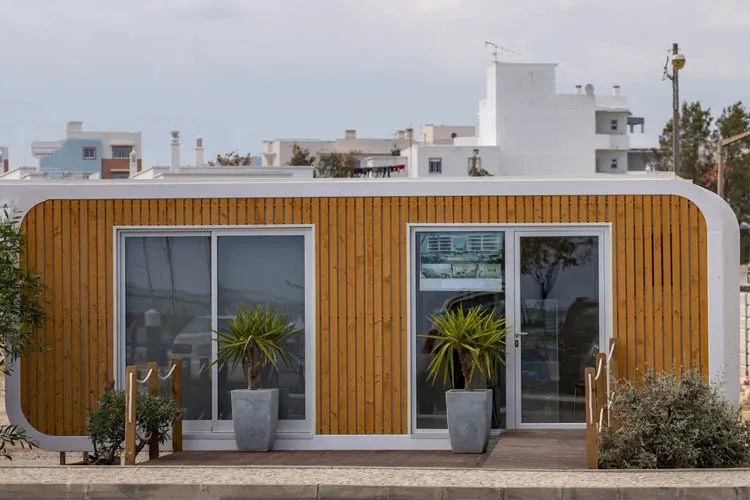With the rise in popularity of container homes, more people are considering moving into these innovative dwellings as a cost effective alternative to a traditional house. You will probably have a number of questions and considerations before taking the leap into a container home. Read more about the pros and cons of this structure for a home.
One reason for their popularity is the solid construction of these steel structures. Shipping containers are made to withstand heavy loads and extreme weather conditions including high winds, harsh temperatures and rough seas. By design, they are strong and watertight due to their solid steel construction making them resistant to damage. Due to their inherent strength, potential buyers may be questioning how strong they really are for various living conditions.
A commonly asked question is “Are container homes hurricane proof?” In this post, we delve into the various aspects of how container homes can withstand a hurricane and what you can do to make your dwelling hurricane-proof.
Classification of Hurricanes
Hurricanes are rated based on a grading system known as the Saffir-Simpson Hurricane Wind Scale from 1 to 5 based on the severity of the storm. The ratings are graded as follows:
- Category-1 – 74 to 95 miles per hour (119 to 153 kilometers per hour)
- Category-2 – 96 to 110 miles per hour (154 to 177 kilometers per hour)
- Category-3 – 111 to 129 miles per hour (178.6 to 207.6 kilometers per hour)
- Category-4 – 130 to 156 miles per hour (209 to 251 kilometers per hour)
- Category-5 – 157 mph or miles per hour and above (252.7 kilometers per hour)
How to Make Hurricane-proof Container Homes
The short answer to the question of whether container homes are or can be hurricane-proof is yes, but you need to take certain measures to ensure that this happens. Following the steps described here will help to keep your container home safe even in the event of a category-5 hurricane:
Robust building materials
Container homes are typically constructed from COR-TEN steel, an extremely tough, corrosion-resistant grade of steel. Ensure that your shipping container home is made of this material for an enhanced life.
Minimize Doors and Windows
The more doors and windows you add to your container home the more unstable it becomes. But of course, it’s not practical or aesthetic to have a house with very few windows. High impact doors and windows are an essential component if your container home is in a hurricane zone. These windows are comprised of tough materials like ethylene-vinyl acetate (EVA) or polyvinyl butyral (PVB). When the glass breaks, it will not scatter shards all over the place. Instead, it creates a spider web pattern like when a car’s windshield breaks. Steps you can take to protect your home from hurricanes including the following:-
- Install high-impact glass windows and doors made to withstand storms
- Add hurricane window film which is a clear plastic film that is tough and can stay in place all year as you can’t really tell it’s there
- When in doubt, protect your windows and home by boarding up windows with plywood
- Install storm shutters
Build a Berm
Another good hurricane-proof measure for your container home is to build a berm. A berm is an embankment made of soil. It will add to the safety of your container home by protecting it from storms.
Partial or Complete Burying
If your container home is located in a highly hurricane-prone area then you consider partially or completely bury it. You might find this can save you from a great deal of loss in the event of a high-category hurricane
Consult an Engineer
Additional reinforcements are always a good idea if you live in a hurricane zone. Consult with an engineer to ensure your home is built for safety. This may include additional anchors, reinforced steel beams and securing the roof.
Corrosion Protection
You should protect your container home from adverse weather conditions like rain and snow. Check the outer and inner surfaces of your container home for rust and corrosion. Scrape off all the rust until you see the metal. Then apply rust protection agents and paint to the affected areas. Rust and corrosion can greatly reduce the strength of your container walls making it more susceptible to damage from hurricanes.
Install Cladding
By installing cladding, you not only keep the exterior away from the direct effects of adverse weather but also protects the structure from corrosion. It can add a considerable number of years to the lifespan of your container home.
If you take the right precautions, you can make your container home ready to withstand the highest category of hurricanes. It will remain secure and protected for many years. But you need to take that extra effort to make your container home hurricane-ready.
Building Codes
Always check with your local municipality to ensure you are adhering to all building codes. This is true for shipping container homes as well to ensure that your home is safe and up to code.
View this post on Instagram
FAQs
What is the maximum wind tolerance of a shipping container?
Shipping containers can withstand wind speeds of up to 180 miles per hour.
Are shipping containers safe in hurricanes?
A typical hurricane reaches wind speeds of over 150 miles per hour. But shipping containers can withstand hurricanes with the proper precautions.
Are hurricane windows unbreakable?
Use hurricane windows from unbreakable glass which does not shatter like normal glass. Although the glass is incredibly durable, it is not indestructible.
With the right preparation, you can protect your shipping container home from the damages caused by hurricanes. Container homes can be a safe and secure option for those in hurricane zones.


